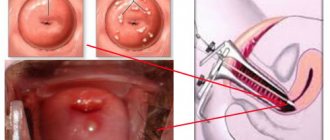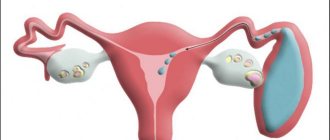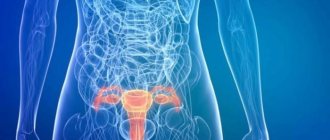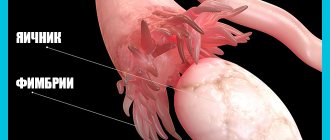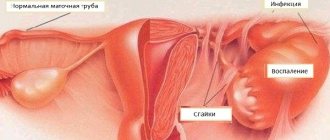What it is?
Most often, the atypical position of the uterus (its bend) is understood as the deviation of the body of the uterus posteriorly in relation to the cervix - this position is called retroflexio. In this case, the body and fundus of the uterus are located towards the sacrum, or also called “posteriorly” (Figure 1).
This position of the uterus is a variant of the normal position and, in most cases, does not cause any inconvenience to the woman. In one out of five healthy women, the retroflexio position is due to the congenital position of the uterus or can be acquired. However, there are fixed cases of uterine bending, which are described in some gynecological diseases.
Figure 1. Uterus in retroflexio position
For example, due to salpingitis or endometriosis with the formation of adhesions in the past, the uterus may lose anatomical mobility and remain in the retroflexio position for a long time. With the described condition, the risk of complications during pregnancy increases, which include strangulation and compression of the developing fetus. Fortunately, such situations are rare.
The retroversio position means that both the body and the cervix are directed toward the sacrum (Figure 2).
Figure 2. Uterus in retroversio position (highlighted in lilac)
Bend of the cervix: causes
- Deflection of the uterus is more often detected as a congenital condition and is an anatomical feature of a woman, which can be caused by general or sexual infantilism. But it is worth remembering that bending can provoke various kinds of pathologies of the woman’s reproductive system, for example, various kinds of inflammatory diseases of the appendages or adhesions.
- Often the cause of the formation of a bent cervix is endometriosis or various types of inflammatory processes of the rectum.
- The ligaments that support and attach the uterus may be weakened due to uterine hypoplasia. What is possible in the presence of frequent abortions or childbirth with short intervals of time, due to the age characteristics of the woman. Often the cause of bending is frequent surgical interventions.
- The constitution of the body is also of great importance. It has been proven that the defect is most often registered in young women with low weight, with insufficiently developed muscles and skeleton - asthenics.
Causes
As in non-pregnant women, during pregnancy the retroflexio position is not pathological; about 10-20% of pregnant women have a posterior or anterior bend in the early stages of gestation. If the situation does not change in the second trimester, this is considered a risk factor for compression of the developing fetus.
The following are reasons in non-pregnant women that may cause bending of the body and cervix:
- Chronic salpingitis with adhesions in the pelvis.
- Endometriosis, mainly third and fourth degrees.
- Tumors adjacent to and putting pressure on the uterus.
- Ovarian tumors.
- Leiomyomas.
- Allen-Masters syndrome: a condition caused by traumatic rupture of the fascial tissue of the broad uterine ligaments and the uterosacral ligaments.
- Anomalies in the development of the Müllerian ducts.
Pregnancy can also be attributed to the causes of a bent uterus. In the pelvic cavity, the uterus is held in place by special ligaments that stretch significantly during pregnancy and, as a result, the position of the uterus can change after the birth of the child. For most women, after childbirth, the uterus returns to its original position.
Symptoms
As a rule, this pathology goes away in the absence of any characteristic symptoms. Very often, a girl can be diagnosed with this during her first examination by a gynecologist or when registering for pregnancy.
Signs of a bent uterus:
- Frequent urge to urinate when bending forward. When the uterus moves forward, there is strong pressure on the bladder, this becomes the main reason for frequent urge.
- Dysregulation of the act of defecation. This symptom occurs when it is bent backwards, as the rectum is compressed, which causes difficulty in the passage of feces.
- Pain during sex.
- Painful menstruation.
- Violation of a woman’s reproductive function, which can cause complete infertility, depending on the severity of the bend.
- Frequent miscarriages are also the main symptom of a bent uterus.
If the pathology was detected during pregnancy, then the woman is at risk of spontaneous abortion. In this case, at the first unpleasant symptoms, it is better not to hesitate to contact a gynecologist. Treatment, as a rule, consists of prescribing medications that help maintain pregnancy and give birth to a healthy baby at term.
Very often, when bending, girls may experience symptoms such as excessive leucorrhoea, discomfort during urination, pain during sexual intercourse, constipation, and bloating.
Why is a bent uterus dangerous? The trouble is that this pathology becomes the main reason for the inability to conceive a child. Because if the uterus is positioned incorrectly, the normal movement of sperm to the egg becomes difficult. As a result, the latter is not fertilized and pregnancy does not occur. This process can continue for a long time until the woman determines that the symptoms she feels indicate a bending of the uterus. That is why it is important to consult a specialist in time to begin proper treatment.
What types of bending are found?
The body of the uterus is the middle section of the organ, which with its wide anterior-superior part continues into the fundus, and its narrowed posterior-inferior part into the cervix. From the point of view of normal anatomy, there are two main positions of the uterus:
- Retroflexio – deviation of the uterine body towards the sacrum;
- Retroversio – the body and cervix are directed towards the sacrum, with no significant bend;
- Anteflexio – the body of the uterus is deviated towards the pubic bone;
- Anteversio - the body of the uterus and its cervix are directed towards the pubic bone.
All four positions (bends) are normal options for the location of the organ in the pelvic cavity.
Pathological variants of bending include:
- The position of the cervix and uterus is posterior or anterior only when a pathological process in the pelvic area is confirmed - the presence of adhesions, tumors and other conditions when the uterus loses its anatomical mobility;
- Incarceration of the uterus (during pregnancy);
- Torsion of the uterus - only a few cases have been described in history;
- Inversion (eversion) of the uterus - the frequency is 1 case in 2000 - 23,000 births. Inversion not associated with childbirth is rare and occurs due to prolapse of a uterine tumor;
- Hernial protrusion of the uterus through a muscular defect of the anterior abdominal wall, occurs during the period of actively growing uterus during pregnancy;
- Prolapse (prolapse) or prolapse of the uterus.
Tumors of the uterine appendages and myometrial formations can disrupt the natural position of the uterus, distort its shape and cause dysuric disorders.
Treatment
Curvature of the uterus is treated only after a diagnosis has been made by a clinician. Eliminating the root cause will help correct the bend.
The doctor prescribes the following measures:
- taking anti-inflammatory medications;
- physiotherapy;
- vitamin therapy;
- physiotherapy;
- diet;
- surgery;
- gynecological massage.
The doctor can prescribe surgical treatment only if adhesions are detected on ultrasound, then laparoscopy is performed.
Exercises for uterine flexion are often prescribed, as they have a positive effect on eliminating pathology. Kegel exercises are popular, and they also help prevent prolapse of the internal genital organs and solve problems associated with hemorrhoids and urinary incontinence.
Exercises that the doctor may prescribe:
- contract and relax the pelvic muscles alternately;
- strain your pelvic muscles for 6-10 seconds;
- strain each section of the vagina in turn.
It will be beneficial to perform all the exercises in different positions: standing, sitting, lying on the floor.
Clinicians have noted that there is no need to spend a long time in an upright position or perform heavy physical exercise: this can negatively affect the condition of the organ.
Uterine bending massage involves, and it should be carried out by a gynecologist in his office. The patient is seated in a gynecological chair in which the back is slightly tilted. The massage is carried out both from the inside, which allows the doctor to break up existing adhesions and massage the ovaries, and from the outside. If a woman feels strong, unpleasant and painful sensations during the session, then the duration of the procedure is reduced.
Gynecological massage
Gynecological massage has a number of contraindications, such as:
- deviation of body temperature from normal;
- the presence of infectious processes in the genitourinary system;
- malignant neoplasms in the genitourinary system;
- congenital pathology;
- pregnancy, lactation;
- cervical erosion;
- period of menstruation.
Gynecological massage is not performed if less than two months have passed since the birth, an abortion or any surgical intervention was performed.
It is known that healthy sperm pass into the fallopian tubes within one minute, regardless of the position at the time of ejaculation. Some believe that special poses when bending the uterus play an important role. The most common posterior bending of the uterus involves postures for conception that are similar to the knee-elbow position, when you can kneel, lie on your side - there are many options. And also the postures for conception when the uterus is bent - the classic and the rear pose - have a positive effect on conceiving a child.
Doctors have proven that it takes a maximum of six months to get pregnant when the uterus is bent. Almost all women with this type of pathology in the structure of the organs of the reproductive system carry a baby perfectly.
Main symptoms
Despite the fact that any type of uterine bending without the presence of concomitant pathology in a woman is a variant of the normal location, there are a number of symptoms that may bother the patient. These signs include:
- Discomfort or feeling of pressure in the pelvic area.
- Chronic, moderate pelvic pain.
- Painful menstruation.
- Dyspareunia is pain during sexual intercourse.
- Difficulties with conception and spontaneous abortions.
- Constipation.
- Difficulty urinating and urinary retention.
Important. If the above symptoms are combined and present for a long time in a woman’s life, this is a reason to immediately consult a doctor and undergo additional examination.
Main reasons
With congenital bending of the uterus, the true causes are hidden in a violation of intrauterine development. However, the acquired form can be caused by a number of the following factors:
- The process of formation of adhesions, which can begin after operations in the pelvic area.
- Inflammatory processes of the genital organs.
- Endometriosis.
- The presence of tumor formations in the uterine area. For example, fibroids can cause an organ to shift to one side or another. Moreover, the woman will have a predominance of symptoms that are caused by the underlying disease, and not by pathological displacement of the uterus.
- Injuries during childbirth (especially multiple ones) and unsuccessful abortions. In this case, the muscles of the uterus relax, and it gradually begins to change its location.
Treatment of this problem is recommended, since in many cases it can disrupt the reproductive functions of the female body.
Do they install a spiral?
According to the American Association of Obstetrics and Gynecology and the Centers for Disease Control and Prevention (CDC), the IUD is one of the most reliable, reversible methods of contraception for women of childbearing age. Its installation in women with different types of uterine bends does not differ in any way compared to women whose position of the uterus in the pelvis is more midline. Installation of the spiral requires the skill of a doctor.
Before directly inserting the device into the uterine cavity, the doctor carefully checks the position, angle of inclination and depth of the uterine cavity. These manipulations are extremely important before the procedure itself and minimize the risk of injury. Next, the cervix is pulled in the direction of the vaginal canal, which helps to insert the device regardless of the angle of the uterus.
How to treat a bent uterus
As we have already found out above, often the cause of bending is adhesions in the pelvis caused by chronic inflammatory processes in the area of the appendages, STIs or previous gynecological operations. Surgical abortion is also among the likely causes of uterine retroflexion. To get rid of them, in advanced cases, laparoscopy is performed. In case of an infectious nature, anti-inflammatory drugs, antibiotics, etc. are first prescribed.
After the main course of treatment, procedures are needed that will prevent relapse of inflammation and complications, including pathological displacement of the uterus. To do this, according to indications, gynecologists prescribe hormonal drugs or contraceptives according to the scheme, physiotherapy and manual techniques for influencing the female internal genital organs. Among the latter, the leading role in the correction of retroflexion belongs to special massage techniques affecting the pelvic organs in combination with some “folk” methods. In addition to this, physical therapy exercises such as Kegel exercises are considered the best exercises for correcting the mobile pelvic muscles.
Treatment of a bent uterus with folk remedies
Rear displacement of the uterus caused by external factors is successfully corrected in gynecology using various techniques. As a therapeutic therapy, gynecological massage is prescribed in cases where the cause of the bend is chronic inflammation in the appendage area, weakness of the pelvic muscles, and various ovarian dysfunctions. This method is good because without surgical intervention and consequences it is possible to restore the correct position of the uterus, improve and strengthen the intimate muscles of the pelvic floor and soften and reduce adhesions. This procedure corrects and removes the bend; pelvic massage, when performed correctly, relieves pain during sexual intercourse, increases the chances of conception and pregnancy, and improves a woman’s overall well-being.
The technique of performing manual massage in the treatment of posterior bending of the uterus has its own characteristics. In this case, the causative factor and the spatial position of the displaced organ in the pelvis are taken into account. Therefore, in addition to certain technical nuances in performing this procedure, gynecological specialists recommend combining it with such “folk remedies” as hirudotherapy and mud sessions, as well as physiotherapy. Performed in various combinations during the course, they significantly increase the chances of success. Treating retroflexion with gynecological massage also helps stop further progression of the disease.
Surgical intervention for this gynecological pathology is performed in advanced cases and in the presence of special indications.
Thus, in the presence of a posterior bend or displacement from the axis of the uterus to the left or right, in addition to the massage mentioned above, physiotherapy, mud procedures (rectal administration), and placement of leeches have shown effectiveness in gynecological practice. Their skillful combination allows the specialists of our clinic to correct the curvature of the uterus and help a woman get pregnant as quickly as possible!
Find out more on this topic:
- WHAT IS WORRIED
- There is discharge
- Itching and burning
- Pain in the lower abdomen
- Intimate pain
- Delay of menstruation
- Pain when urinating
- Vaginal odor
- Pain during menstruation
- How not to get pregnant
Diagnostic methods
One of the ways to determine the position of the uterus is bimanual palpation, which is performed by an obstetrician-gynecologist during an examination.
The main instrumental screening method for diagnosing the anatomical structure and location of an organ is ultrasound, which can be performed transvaginally (the sensor is inserted into the vagina) and transabdominally (through the abdomen).
A transabdominal examination is performed with a full bladder, which is a kind of “window” through which the uterus and appendages are visualized. The most informative is considered to be a transvaginal examination, which does not require filling the bladder.
Definition
Deformation of the cervix is usually understood as a violation of the integrity of the vaginal part of the organ, which provokes the appearance of a large scar. It is the scar that causes dramatic changes in the shape of the uterine cervix and cervical canal.
Deformation of the cervix leads to unimaginable consequences: microcirculation of blood in tissues is disrupted and nerve cells die. This process causes trophic changes in the cervical canal.
In addition, if no action is taken to eliminate this pathology, changes can affect the organ itself: eversion of the uterine mucosa into the vagina or the formation of vaginal fistulas.
Ignoring this disease can cause complications:
- cervical erosion;
- endocervicitis;
- endometritis;
- atrophic changes in epithelial tissues;
- neoplasms of a malignant or benign nature.
In most cases, the deformity causes infertility or miscarriage. Therefore, if a woman is planning a pregnancy, cervical deformity must be treated.
Treatment of pathology
Since the uterine positions described above (retroversio/retroflexio, anteversio/anteflexio) are not pathological, no treatment is required. The uterus in the retroflexio position during pregnancy, without the presence of adhesions or other pathological process, can be pinched in the area of the promontory of the sacral bone due to a combination of not only a pronounced bend, but also weakness and pliability of the soft tissues. Symptoms - pelvic pain and urinary retention - appear between the twelfth and fourteenth weeks of pregnancy.
The principles of treatment of pathological posterior bending with strangulation during pregnancy are as follows:
- Emptying the bladder by installing a catheter;
- Manual removal of pathological bending by a physician with or without the use of tocolytics and anesthesia;
- Manipulation to eliminate the bend using colonoscopy;
- Sleeping in a prone position on your stomach.
Treatment and diagnosis
A doctor can diagnose the pathology during a routine examination in a gynecological chair. Using the palpation method, he establishes the location of the uterus, its size and correct location in relation to the ovaries. If a bend is suspected, the patient is sent for an ultrasound examination, which accurately determines the shape of the pathological location of the uterus. Only after this individual treatment is prescribed.
In some cases, when carrying out massage treatment, the doctor can independently correct the incorrect position of the organ, but after a while the problem can return again, so it is important not only to correct the bend, but also to eliminate the cause of its appearance.
Having felt the first unpleasant symptoms, a woman should contact a gynecologist, who will select the correct treatment for her case.
As a rule, treatment for uterine flexion caused by adhesions involves removing adhesions. Surgical treatment is performed laparoscopically. After this, a course of painkillers, anti-inflammatory and antimicrobial drugs is prescribed. If there are a lot of adhesions, then abdominal surgery is performed to remove them.
If the bending of the uterus is not accompanied by unpleasant symptoms, then doctors recommend not to carry out any treatment.
To achieve pregnancy, you need to use the right positions that will help correct difficulties with conception. With the correct selection of positions during sexual intercourse, the chances of fertilization of a mature egg increase several times. That is, with such a pathology, you need to consult a sexologist as a treatment for infertility.
What exercises are useful for uterine flexion?
To relieve and prevent pain during menstruation, the following is recommended:
- Take the knee-elbow position for 5-7 minutes, repeat 2-3 times a day;
- Strengthen the pelvic floor muscles by performing Kegel exercises - during the intermenstrual period.
You need to understand that there are no special exercises for bending the body and cervix posteriorly or anteriorly. Often after pregnancy and childbirth, women report less painful sensations during menstruation.
Is it possible to get pregnant with a retracted uterus?
The main cause of infertility when the uterus is bent is adhesions. In this case, sperm cannot pass through the cervix because an acute angle is formed.
You can get pregnant with a retracted uterus if you follow these recommendations:
- It is necessary to die your life rhythm. Spend as little time as possible on your feet, try not to lift heavy objects, and avoid intense sports activities.
- Select special positions for sexual intercourse. It must be taken into account that the cervix is tightly closed, sperm cannot overcome the barrier, so it is best to use the “back” position. Also, after intercourse, a woman should lower her head below her pelvis and remain in this position for about 10 minutes. Then lie down and rest for half an hour.
What do you need to remember?
- The uterus is a mobile organ, and its different position in women is the norm.
- The causes of fixed bends are associated with pathological processes in the pelvis.
- There are four main anatomical positions of the uterus in the pelvic cavity, which are often called folds.
- Most women do not experience complaints when the uterus is bent.
- Curvatures of the uterus do not affect the course of menstruation and the menstrual cycle.
- A curvature of the uterus does not reduce the chances of pregnancy.
- Physiological bends do not pose any danger to women.
Prevention
To prevent the development of pathological displacement of the organ, a woman needs to monitor her lifestyle, try to avoid high-heeled shoes, observe a work and rest schedule, and minimize the carrying of heavy objects. It is also necessary to avoid infections of the genital organs and treat all inflammatory processes in a timely manner. In general, if you visit a gynecologist 2 times a year for a mandatory examination, you can avoid not only this pathology, but also many other diseases. It is important not to miss the first alarming symptoms that may be the cause of the pathological process.
Thus, a pathological deviation in the location of the uterus is not a serious obstacle to pregnancy if the bend is slightly expressed. This process can occur without unpleasant symptoms, and the patient learns about the diagnosis only during an examination by a gynecologist. The causes of the acquired form of bending can be varied; only high-quality treatment can eliminate them. Therefore, if you feel any unpleasant symptoms, you should not delay contacting a specialist, since only he will be able to select the optimal treatment methods - physical therapy, massage.
The use of traditional medicine methods in this case can cause unwanted complications.

